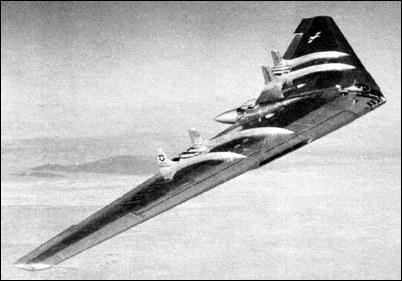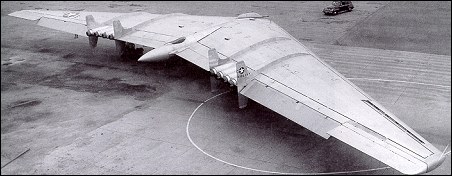|
| The end of World War II, together with orders placed for the competing Convair B-36, sealed the fate of the piston-engine B-35, but foreseeing this possibility Northrop received approval from the USAF to modify two of the YB-35s to jet power. Redesignated YB-49, the first of these flew on 21 October 1947 with eight 1814kg thrust Allison J35 engines; the second had six 2540kg thrust Allison engines, four buried in the wings and two in underslung pods. Many complimentary reports on the YB-49 were filed by air force officers, and the service was convinced of the advantages of the all-wing configuration, but in June 1948 the second YB-49 was destroyed with the loss of its five man crew in a crash attributed to structural failure.
In spite of this the US Air Force ordered 30 modified RB-49A aircraft, one of which was to be built by Northrop and, because of that company's other commitments, 29 by Consolidated Vultee, but this order was later cancelled to provide extra funds for the B-36. The YB-35 programme continued for a while with various test airframes, but in October 1949 the whole programme was cancelled and the aircraft were scrapped. Sole survivor was the six-jet YB-49A, but just four years later this was broken up.
FACTS AND FIGURES © One theory for the YB-49 crash
was that the design was not
adjusted to counter the stability lost
when the propellers were omitted. © The YB-49 was powered by six
jets. The last model, the YRB-49,
had two of the jets in auxiliary
pods under the wings. © Curing the stability problems with
the flying wings was beyond the
technology of the time. Computers
and fly-by-wire systems keep the
modern B-2 under control.
 | A three-view drawing (556 x 319) |
| CREW | 6 |
| ENGINE | 8 x Allison J35-A-15, 1800kg |
| WEIGHTS |
| Take-off weight | 96800 kg | 213409 lb |
| DIMENSIONS |
| Wingspan | 52.4 m | 172 ft 11 in |
| Length | 16.2 m | 53 ft 2 in |
| Wing area | 372 m2 | 4004.17 sq ft |
| PERFORMANCE |
| Max. speed | 930 km/h | 578 mph |
| Range | 8700 km | 5406 miles |
| Jim Evans, e-mail, 02.07.2008 04:56 The loss of the YB-49 in a midair breakup deprived the Air Force of stealth technology some forty years ahead of its time, but it gave two U. S. Air Force bases their namesakes: Edwards AFB (the old Muroc field) in California for the copilot Capt Glen Edwards and Forbes AFB (the old Topeka AAF) for the pilot Maj Daniel Forbes. reply | | Terrence O'Neill, e-mail, 22.05.2008 16:48 Read my new book: "GM,DS! A Billion Dollar Bluinder". From government microfilmed records of the R&D projects of the -35 and the -36, an airplane designer can see the greatly superior performance of the YB-49, even when saddled with the inefficient 'stove-pipe' J-35s instead of the newer J-47s the Boeign B-47, its competition as a 2000-mile-target bomber. But the m ajor difference is what Charles Tucker relates, that it was stealthy in 1948! He was on board on flights requested by GCI radar around San Francisco, and repeatedly made invisible passes, though the radar picked up other aircraft. The AF Generals chose to ignore this breakthrough.
Tucker flew the Wing through all the AF-required stall tests, after the No. 2 -49 had crashed, when Forbes pulled the wigns off at 4.8Gs. (There was no G-meter, and he started too low for a gradual pull-out.) Tucker sinsists the Wing was rock-solid and an excellent airplane, coudl turn-inside a P-80, had flown 520-mph, and landed half as fast as its competition, the 1500-mile-target Boeing B-47. reply | | Terrence O'Neill, e-mail, 22.05.2008 16:48 Read my new book: "GM,DS! A Billion Dollar Bluinder". From government microfilmed records of the R&D projects of the -35 and the -36, an airplane designer can see the greatly superior performance of the YB-49, even when saddled with the inefficient 'stove-pipe' J-35s instead of the newer J-47s the Boeign B-47, its competition as a 2000-mile-target bomber. But the m ajor difference is what Charles Tucker relates, that it was stealthy in 1948! He was on board on flights requested by GCI radar around San Francisco, and repeatedly made invisible passes, though the radar picked up other aircraft. The AF Generals chose to ignore this breakthrough.
Tucker flew the Wing through all the AF-required stall tests, after the No. 2 -49 had crashed, when Forbes pulled the wigns off at 4.8Gs. (There was no G-meter, and he started too low for a gradual pull-out.) Tucker sinsists the Wing was rock-solid and an excellent airplane, coudl turn-inside a P-80, had flown 520-mph, and landed half as fast as its competition, the 1500-mile-target Boeing B-47. reply | | Dr Lyle G McNeal, e-mail, 19.05.2008 00:54 My father as an executive with Northrop Aircraft and employee for from day 1 when Jack Northrop founded this unique corporation and had great involvement with all of the Northrop flying wings, the piston -35 and the jet -49. I saw both of these take their maiden flights and was totally impressed. I also remember my father discussing with me the negative contractual politics and how they kept losing to Convair and the B-36 'white elephant' bomber. As a pilot myself, I was sensitive to what I understand about the flying issues, but minor in contrast to the poorly designed and performed Convair B-36. The sad part of this commentary is that the D.C. politics hasn't change much.....just look at the European Airbus federal contract! reply | |
| | Iron Mountain Man, e-mail, 22.01.2008 00:00 Please see my lengthy post on the XB-35.
The September 1950 issue of National Geographic magazine has a quote from an engineering test pilot stating that the yaw problem with the YB-49 was solved by adding two gyroscopes taken from salvaged Boeing B-29s. The two other gyroscopes were slaved to the master 'gyro and the yaw problem vanished completely.
The jet YB-49 had even LESS radar cross section than its piston powered ancestor. reply | | paul panozzo, e-mail, 09.01.2008 05:53 TRULY A AIRCRAFT ADHEAD OF ITS TIME.GRANDADDY OF THE B2 AND F117A.REASON WHY THE USAF DID NOT PROCURE THIS AIRPLANE
WAS THAT IT HAD A HABIT OF YAWING DURING A BOMB RUN. reply | | alan vintiner, e-mail, 12.04.2007 16:08 I first saw this aircraft on the original version of war of the worlds, it dropped an atomic bomb on the martins and I thought then that it was a great plane. Interesting to see a similar shape in the stelth bombers. reply |
|
Do you have any comments?
|
| 
COMPANY
PROFILE
All the World's Rotorcraft
|








